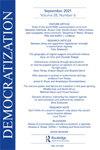The Way Out: How to Overcome Toxic Polarization
IF 2.9
1区 社会学
Q1 POLITICAL SCIENCE
引用次数: 0
Abstract
eralized for other contexts that face similar degrees of violence and inequalities. The book has a clear writing style and structure. The author is highly-knowledgeable on the topic and the book presents a comprehensive discussion of previous research making clearer what we know to date about these matters and what contributions the book brings to the literature. The book reflects much creativity and originality from the first to the last chapter. It advances an original theory of institutional change that explains how and why the structural power of the police influences policy agendas and societal dynamics. The latter influences the politicians’ willingness to maintain or oppose the persistence of coercive practices and structures. The results are based on extensive efforts to gather and analyze data from the ground and official documents. To answer the research question, the author uses process tracing eloquently, almost as a textbook example for the use of data and alternative explanations. The conclusions explain in a compelling manner how and why its findings could be generalized to other contexts with similar degrees of violence and social inequalities. The book has some points that could have been approached more rigorously to increase the proposed approach’s transparency and replicability. For example, a more detailed and nuanced discussion about the collection and selection of data would be very relevant for a broad range of readers. The source of some data and how the interviewees were selected and approached remain unclear. Also, while the author explained rigorously how the cases were selected, it still remains unclear if the selected cases are indeed the most relevant for Latin America. The author’s efforts to bring this book to life are commendable. Her approach advances new knowledge in the field of democratization and the persistence of violence in new democracies. The empirical and theoretical contributions of this book address large audiences that vary from academics to practitioners, policy-makers, and the broader public. Although the book fully achieved its ambitions, it definitely opens the door for further research. Some of the possible avenues are acknowledged by the author along the lines of citizens’ preferences towards some of the police’s actions in the new democracies.出路:如何克服有毒两极分化
在其他面临类似程度暴力和不平等的情况下。这本书的写作风格和结构都很清晰。作者对这个话题非常了解,这本书对以前的研究进行了全面的讨论,使我们迄今为止对这些问题的了解更加清晰,这本书给文学带来了什么贡献。这本书从第一章到最后一章都体现了很大的创造性和独创性。它提出了一种制度变革的原始理论,解释了警察的结构性权力如何以及为什么影响政策议程和社会动态。后者影响着政治家维持或反对强制性实践和结构的意愿。这些结果是基于对实地数据和官方文件的广泛收集和分析。为了回答研究问题,作者雄辩地使用了过程追踪,几乎作为使用数据和替代解释的教科书示例。结论以令人信服的方式解释了其研究结果如何以及为什么可以推广到具有类似程度暴力和社会不平等的其他情况。这本书有一些点,可以更严格地接近,以增加所提出的方法的透明度和可复制性。例如,关于数据收集和选择的更详细和细致的讨论将与广泛的读者非常相关。一些数据的来源以及如何选择和接触受访者仍然不清楚。此外,虽然作者严格解释了这些案例是如何选择的,但仍然不清楚所选择的案例是否确实与拉丁美洲最相关。作者为使这本书栩栩如生所作的努力值得赞扬。她的方法推动了民主化领域的新知识和新民主国家暴力的持续存在。本书的经验和理论贡献面向从学者到从业者、政策制定者和更广泛的公众的大量受众。虽然这本书完全实现了它的野心,但它无疑为进一步的研究打开了大门。根据新民主国家中公民对警察的某些行为的偏好,作者承认了一些可能的途径。
本文章由计算机程序翻译,如有差异,请以英文原文为准。
求助全文
约1分钟内获得全文
求助全文
来源期刊

Democratization
POLITICAL SCIENCE-
CiteScore
6.40
自引率
12.50%
发文量
73
期刊介绍:
Democratization aims to promote a better understanding of democratization - defined as the way democratic norms, institutions and practices evolve and are disseminated both within and across national and cultural boundaries. While the focus is on democratization viewed as a process, the journal also builds on the enduring interest in democracy itself and its analysis. The emphasis is contemporary and the approach comparative, with the publication of scholarly contributions about those areas where democratization is currently attracting considerable attention world-wide.
 求助内容:
求助内容: 应助结果提醒方式:
应助结果提醒方式:


